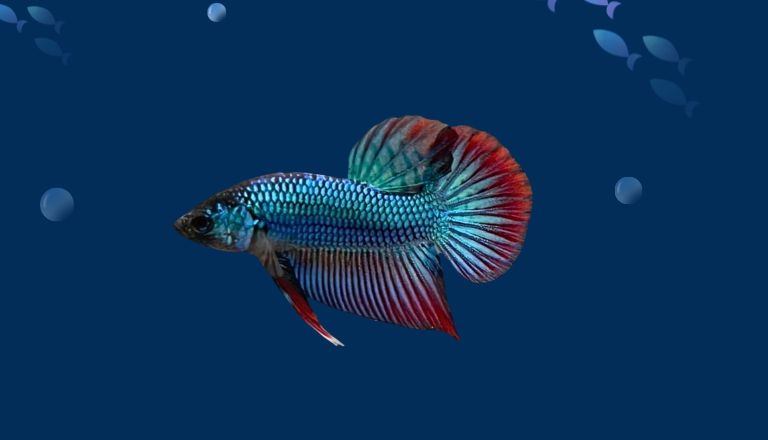Spade Tail Betta Fish Care Guide & Species Profile
Are you looking to add a unique and captivating fish to your aquarium? Look no further than the stunning Spade Tail Betta Fish! With its elegant flowing fins and vibrant colors, the Spade Tail Betta is a mesmerizing species that brings beauty and charm to any fish tank. In this comprehensive care guide, we will discuss everything you need to know about caring for these fascinating creatures.
Whether you’re a beginner fish keeper or a seasoned enthusiast, join us on a journey into the world of SpadeTail Bettas and discover why they make such wonderful additions to any aquatic collection.
Spade Tail Betta Fish Facts & Overview
Spade tail betta fish, also known as the Plakat Betta, is a unique species originating from the murky waters of Southeast Asia.
Spade tail bettas have a simple look with red and brown colors. They are small, only growing up to 2 inches long. They are tiny and have fins that look like a spade
In the wild, they are found in slow-moving streams and shallow rice paddies. They are good at hiding in plants and catching prey.

These stunning fish have a unique spade-shaped tail that distinguishes them from other Betta variations.
Their simple beauty and graceful swimming make them interesting in aquariums. With the right care and clean water, spade tail bettas can do well in tanks for both beginners and experienced fish keepers.
Origin
The Spade Tail Betta fish originates from Thailand and Cambodia. Breeders have selectively bred these fish to enhance their vibrant colors and distinctive fin shapes.
In their natural habitat, Spade Tail Bettas can be found in shallow rice paddies and slow-moving streams. Their ability to thrive in varied environments has made them popular among aquarium enthusiasts worldwide.
Spade Tail Betta Size & Lifespan
The Spade Tail Betta is a smaller variety of Betta fish with a distinct spade-shaped tail. On average, these fish grow 2.5 inches in length. Despite their small size, they are known for their vibrant colors and unique fin shapes that make them stand out among other freshwater fish.
Spade Tail Bettas typically live for around 2-3 years when kept in optimal conditions. Factors such as water quality, diet, and tank size play a role in determining the longevity of these beautiful creatures. By providing a well-maintained environment with proper nutrition and care, you can maximize the lifespan of your Betta and enjoy their captivating presence for years to come.
Appearance
The spade-tail betta is a beautiful fish known for its colorful appearance. It has vibrant colors like blue, purple, red, and orange. The fish’s scales shine in the light, giving it a special look. The betta’s fins are striking, shaped like a spade, and add elegance.

They swim gracefully with fins that move like silk ribbons. The spade tail betta is elegant and beautiful, making it a popular choice for aquarium enthusiasts who want a visually stunning fish.
Behavior
Spade tail bettas are fascinating fish to watch because of their unique behaviors. They are active and territorial. They show aggression towards other fish. They fiercely defend their space in a tank.
When threatened, they flare up and show bright colors to assert dominance and warn rivals. Before breeding, they perform courtship rituals, with the male dancing to attract the female. Studying spade tail bettas’ behavior can help us learn about their social dynamics.
Habitat and Tank Requirements
These bettas thrive in aquariums that mimic their natural habitat in Southeast Asia. provide ample space for swimming and exploration, and maintain stable water parameters.
When setting up a tank for Spade tail bettas, include live or silk plants that offer hiding spots and resting areas. You can also add floating plants like duckweed or water lettuce, which help diffuse light and provide shade.
Tank Conditions
The optimal tank size for a Spade Tail Betta is at least 5 gallons, providing ample swimming space and room for decorations. Bettas are territorial fish, so having enough space helps reduce aggression.
Keep the water temperature between 75-80 degrees Fahrenheit and pH levels around 6.5-7.5. Regularly test for ammonia, nitrites, and nitrates to ensure a safe environment for your fish. Perform regular water changes of at least 25% every, this will keep the tank clean and maintain optimal water quality.
By creating an environment that simulates their natural habitat, you can ensure that Spadetail bettas thrive and display their full beauty in the aquarium setting.
Compatibility and Tankmates
When selecting tankmates for your Spade tail betta, consider their temperament and compatibility. Peaceful fish such as Neon tetras, Corydoras catfish, or Ghost shrimp are excellent companions for the betta. These species are less aggressive than the betta and can coexist peacefully in the same tank.
Tankmates (To Avoid)
Avoid companions that lead to aggression or stress within the aquarium. Avoiding fin-nipping fish like Tiger barbs or certain Tetra species as they may provoke aggression. Also, avoid large and aggressive fish such as cichlids due to their territorial behavior which can intimidate or harm the more delicate bettas.
Bottom-dwelling fish like catfish or loaches may disturb the peaceful betta by constantly being near its territory at the bottom of the tank.
Provide hiding spots and sufficient space for all tankmates to reduce potential conflicts and promote a healthy tank environment for your Spade tail betta. By carefully selecting compatible tankmates, you can create a vibrant community aquarium.
Diet and Feeding Requirements
These fish are carnivorous by nature. Offer them a variety of foods such as high-quality pellets, frozen or live bloodworms, brine shrimp, and daphnia to provide essential nutrients. Feed your betta small portions multiple times a day to prevent overfeeding and maintain their health.
Incorporating occasional fasting days into your betta’s feeding schedule is beneficial for their digestive system and overall well-being.
Monitor their eating habits closely and adjust the amount of food accordingly. Providing a balanced diet and following a consistent feeding routine plays a vital role in keeping your Spade tail betta healthy and thriving in its environment.
Breeding
Breeding Spade tail bettas can be a rewarding and fascinating experience for fish enthusiasts. When breeding these bettas, create the right environment with optimal water conditions and plenty of hiding spaces for the fish to feel secure during the mating process.
Breeding spade tail bettas is interesting because you can watch them court each other. The males dance and show off their colors to attract females. To breed successfully, watch the pair closely and give them good food to help the female make eggs.
As fry are hatched, separate them from the adult fish and give them small live foods such as infusoria or baby brine shrimp to ensure healthy growth and development.
Conclusion
The Spade Tail Betta fish is a unique and captivating species that makes a wonderful addition to any aquarium. By following the care tips outlined in this guide, you can ensure your Spade Tail Betta thrives in its environment and remains healthy and happy. With proper care and attention, your SpadeTail Betta will reward you with its vibrant colors and playful personality.
FAQs
What is The Lifespan Of A SpadeTail Betta Fish?
The lifespan of a SpadeTail Betta fish ranges from 2 to 4 years. With proper care and a healthy environment, they can live up to 5 years. Factors such as water quality, diet, and genetics play a significant role in determining the longevity of these fish.
What is a Spade Tail Betta?
A Spade Tail Betta is a special type of Betta fish known for its unique tail shape. The spade tail has a broad and round fin that looks like a spade or shovel. This tail differentiates them from other Betta fish types like the Veil Tail or Crown Tail. To keep a Spade Tail healthy, you need to take good care of it by giving it the right tank size, water, and food.
Are Crowntail Bettas more Aggressive than Spade Tail Betta?
Crowntail Bettas and Spade Tail Bettas are types of Betta fish with unique tail shapes. Male Betta fish are usually more aggressive than females because they are territorial. Aggression can also be affected by tank size, water quality, and other fish in the tank. Crowntail Bettas are not more aggressive than Spade Tail Bettas just because of their tail shape.







